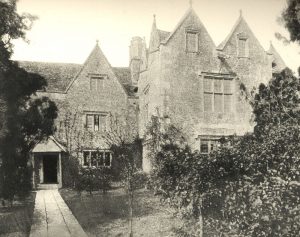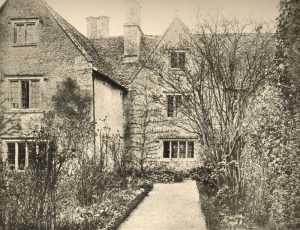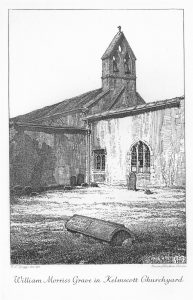Morris’s love of the printed word evolved from his interest in illuminating manuscripts by hand as a hobby, as he did with his Book of Verse. He was catalyzed to move into printing by Emery Walker’s illustrated lecture in November 1888. Soon after attending this lecture, Morris designed a new font, with Walker’s help. Morris was excited about the possibilities of improvement in book design: “Here is a new craft to conquer and to perfect.” Printing began in the spring of 1891, and Morris’s goal was nothing less than to produce the “ideal book.”
The Golden Legend of William Caxton turned out to be the seventh book printed at the press, instead of the first as was intended. This volume was the closest to Morris’s concept of the ideal book and he completed it shortly before his death.
William Morris found it necessary to rethink all aspects of the book. He returned to examples of the fifteenth century printers for inspiration and sought to create text that was beautiful and readable. His solution to this was to create darker more massive typefaces, and to leave less white space in the body of the text. He obtained ink from Germany and paper and vellum from England (once he even sought the Pope’s vellum maker).
Morris’s attention to detail did not extend to book-bindings. The only existing richly-bound Kelmscott books were re-bound by his customers. Kelmscott books were bound very simply, either in vellum covers with cloth ties (pink, green, or gold), or in blue-grey board with a linen spine. Morris assumed his customers would re-bind the books according to their tastes, but he didn’t always include enough margin for this purpose.
Most feel that he did not achieve his goal of combing beauty and legibility. Though his books are undoubtedly beautifully crafted, the type is dense and difficult to read. The text becomes a black block, with no rest for the eyes or deliberate separation between words or sentences.
It seems slightly contradictory that Morris turned away from the practices of contemporary printers and replicated so many of the aspects of medieval texts. In a lecture for the Society for the Protection of Ancient Buildings, Morris addressed the interchange of history, restoration and architecture: “Surely it is a curious thing that while we are ready to laugh at the idea of the possibility of the Greek workman turning out a Gothic building, or a Gothic workman turning out a Greek one, we see nothing preposterous in the Victorian workman producing a Gothic one.” What then of a Victorian printer producing a nearly medieval text?
Through his craft, design, and socialist causes, Morris sought to re-create English taste and the structure of society. He felt that good craft was vital to a good society, and that it should be available to everyone. However, his own works were very expensive and had limited runs and distribution. How can you refine society tastes when only the very wealthy can even afford your work? Paul Thompson, a biographer of Morris, was critical of his efforts, stating that they would have “…been greatly helped by a more cautious assessment of the development of Victorian printing, and especially of the social value of good printing by cheap methods.”
Morris died shortly after being shown the first bound copy of the Kelmscott Press edition of The Floure and the Leafe and the Booke of Cuipe, God of Love, or the Cuckoo and the Nightingale.



